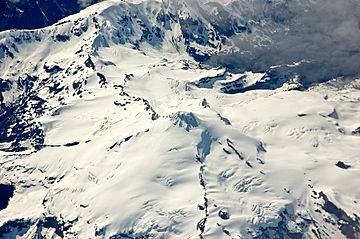Yanteles facts for kids
Quick facts for kids Yanteles |
|
|---|---|
| Yantales | |

Aerial view of one of the Yanteles volcano's major peaks
|
|
| Highest point | |
| Geography | |
| Location | Chile |
| Parent range | Andes |
| Geology | |
| Mountain type | Stratovolcano |
| Last eruption | 6650 BCE (?) |
Yanteles is a volcano in Chile. It has five peaks covered in glaciers. These peaks form a long ridge, about 8 kilometers (5 miles) long. Yanteles is found inside the Corcovado National Park. It is about 30 kilometers (19 miles) south of the Corcovado volcano. Sometimes, the name Yanteles refers only to its main peak. This main peak is also called Volcán Nevado. That means "Snow-covered Volcano" in Spanish.
Contents
Where is Yanteles Located?
Yanteles is in the Chaitén area of the Los Lagos Region in Chile. The towns closest to the volcano are Villa Santa Lucía and Bahía Tic-Toc. The larger town of Chaitén is about 60 kilometers (37 miles) away.
How Big is the Yanteles Volcano?
This volcano is quite large. It covers an area of about 84.5 square kilometers (32.6 square miles). Its height varies depending on the measurement. It has been recorded as 2,042 meters (6,699 feet), 1,790 meters (5,870 feet), or 1,971 meters (6,467 feet) tall.
What Kind of Volcano is Yanteles?
Yanteles is a stratovolcano. This type of volcano is usually tall and cone-shaped. It is built up by many layers of hardened lava, ash, and rocks. Yanteles has three stratovolcanoes that grew along a crack in the Earth. Five peaks form a ridge that points northeast.
Special Features of Yanteles
Yanteles has a caldera. This is a large, bowl-shaped hollow that forms after a volcano erupts and collapses. Inside the caldera, there is a pyroclastic cone. This is a small, steep hill made of volcanic ash and rock fragments. There are also old, worn-down peaks nearby. Some parts, like Nevado and Yeli, are volcanic necks. These are the hardened lava cores of old volcanoes.
Glaciers on Yanteles
Yanteles is covered by large glaciers. In 2007, these glaciers covered about 46.24 square kilometers (17.85 square miles). This makes it one of the biggest ice areas in the region. However, these glaciers are shrinking. They are losing about 0.72 square kilometers (0.28 square miles) of ice each year.
What is Yanteles Made Of?
The lava that has erupted from Yanteles is called basaltic andesite. This is a type of volcanic rock. Yanteles is part of the Southern Volcanic Zone of the Andes mountains.
History of Yanteles Eruptions
Yanteles has been active for a very long time. It was active during the Pleistocene and Holocene periods. Its last big eruption happened around 6,650 BCE. This volcano is thought to be the source of ash layers found in other places. For example, the YAN1 ash layer from about 7,240 BCE might have come from Yanteles. Ash from Yanteles may also be found in Antarctica and lakes in Patagonian.
When Was Yanteles First Known?
Not much was known about Yanteles for a long time. It was mentioned in a book from 1899. People knew it was a volcano as early as 1916.
Recent Activity and Hazards
It is not clear if Yanteles has erupted in recent history. There was a report that it erupted after a big earthquake in 1835. Activity was said to continue for months. However, this report is not very clear. The changes described, like bare rock or disappearing snow, could have been landslides instead of eruptions.
More recently, there has been some minor activity. This includes fumarolic activity in 1982, 1992, and from 1993 to 1995. Fumarolic activity means that steam and gases are coming out of the volcano. In 1993, two areas on the ridge were seen letting out yellow-to-white steam. These areas were about 2 kilometers (1.2 miles) apart.
If Yanteles erupts in the future, it could cause mudflows. These are like rivers of mud and debris that flow down the volcano's sides. They could affect the valleys around the volcano. Experts have classified Yanteles as a type III volcano. This means it has a medium level of volcanic hazard.
See also
 In Spanish: Yanteles para niños
In Spanish: Yanteles para niños
- List of volcanoes in Chile
- Corcovado volcano

